The latest contrarian crowd pleaser from [cite ref=”Soon et al (2023)”]10.3390/cli11090179[/cite] is just the latest repetition of the old “it was the sun wot done it” trope[1] that Willie Soon and his colleagues have been pushing for decades. There is literally nothing new under the sun.
[Read more…] about As Soon as PossibleGreenhouse gases
CMIP6: Not-so-sudden stratospheric cooling
As predicted in 1967 by Manabe and Wetherald, the stratosphere has been cooling.
A new paper by [cite ref=”Ben Santer and colleagues”]10.1073/pnas.2300758120[/cite] has appeared in PNAS where they extend their previous work on the detection and attribution of anthropogenic climate change to include the upper stratosphere, using observations from the Stratospheric Sounding Units (SSUs) (and their successors, the AMSU instruments) that have flown since 1979.
[Read more…] about CMIP6: Not-so-sudden stratospheric coolingNew misguided interpretations of the greenhouse effect from William Kininmonth
I have a feeling that we are seeing the start of a new wave of climate change denial and misrepresentation of science. At the same time, CEOs of gas and oil companies express optimism for further exploitation of fossil energy in the wake of Russia’s invasion of Ukraine, at least here in Norway.
Another clue is William Kininmonth’s ‘rethink’ on the greenhouse effect for The Global Warming Policy Foundation. He made some rather strange claims, such as that the Intergovernmental Panel on Climate Change (IPCC) allegedly should have forgotten that the earth is a sphere because “most absorption of solar radiation takes place over the tropics, while there is excess emission of longwave radiation to space over higher latitudes”.
[Read more…] about New misguided interpretations of the greenhouse effect from William KininmonthA CERES of fortunate events…
The CERES estimates of the top-of-atmosphere radiative fluxes are available from 2001 to the present. That is long enough to see that there has been a noticeable trend in the Earth’s Energy Imbalance (EEI), mostly driven by a reduction in the solar radiation reflected by the planet, while the outgoing long wave radiation does not appear to contribute much. But what can be causing this?
A paper last year [cite ref=”(Goode et al., 2021)”]10.1029/2021GL094888[/cite] also reported on a two decade estimate of Earthshine measurements which appear to confirm a small decrease in albedo (and decrease in reflected short wave (SW) radiation). While the two measurements are subtly different due to the distinct geometries, they do show sufficient coherence to give us some confidence that they are real.
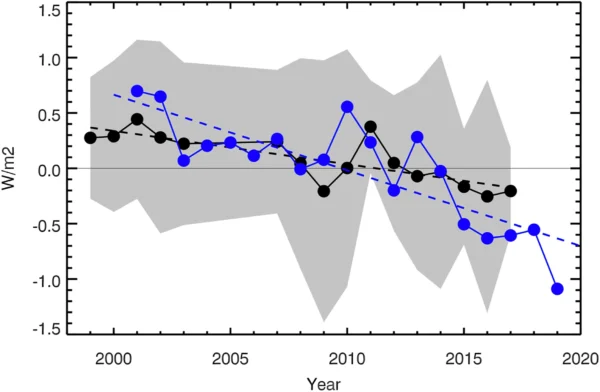
Similarly, [cite ref=”Loeb et al. (2021)”]10.1029/2021GL093047[/cite] show that the trends in the EEI derived from CERES match what you get from the changes in ocean heat content.
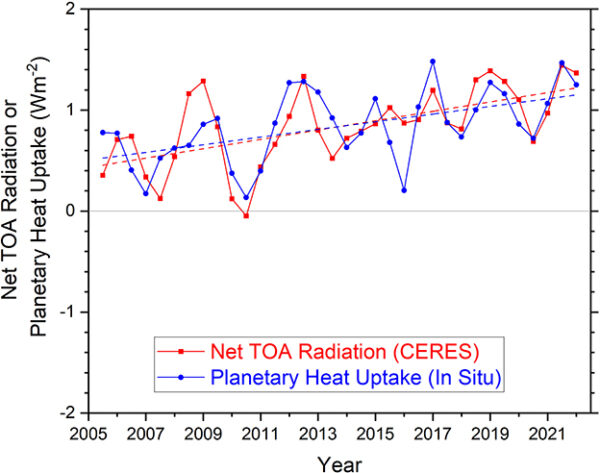
A few people have started to interpret the dominance of the SW trends to imply that the overall trends in climate are not (despite copious evidence) being driven by the rise in greenhouse gases (for instance, the rather poorly argued and seemingly un-copyedited [cite ref=”Dübal and Vahrenholt (2021)”]10.3390/atmos12101297[/cite]) but these simplistic interpretations are seriously confused.
We can explore the issues and pitfalls of this using the ‘simple model’ of the greenhouse effect we explored back in 2007. At that time, we said:
[Read more…] about A CERES of fortunate events…You should think of these kinds of exercises as simple flim-flam detectors – if someone tries to convince you that they can do a simple calculation and prove everyone else wrong, think about what the same calculation would be in this more straightforward system and see whether the idea holds up. If it does, it might work in the real world (no guarantee though) – but if it doesn’t, then it’s most probably garbage.
Climate impacts of the #IRA
With the signing of the Inflation Reduction Act (IRA) on Tuesday Aug 16, the most significant climate legislation in US federal history (so far) became law.

Despite the odd name (and greatly overused TLA), the IRA contains a huge number of elements, totalling roughly $350 billion of investment, in climate solutions over the next ten years. This is an historic effort though it falls short of the broader ‘Green New Deal‘ goals that were proposed in 2019, and doesn’t include all of the elements that were in the proposed 2021 reconcilliation package (the American Jobs Plan in “Build Back Better“) that ultimately floundered.
[Read more…] about Climate impacts of the #IRAThe CO2 problem in six easy steps (2022 Update)
One of our most-read old posts is the step-by-step explanation for why increasing CO2 is a significant problem (The CO2 problem in 6 easy steps). However, that was written in 2007 – 15 years ago! While the basic steps and concepts have not changed, there’s 15 years of more data, updates in some of the details and concepts, and (it turns out) better graphics to accompany the text. And so, here is a mildly updated and referenced version that should be a little more useful.
[Read more…] about The CO2 problem in six easy steps (2022 Update)Mmm-k scale climate models
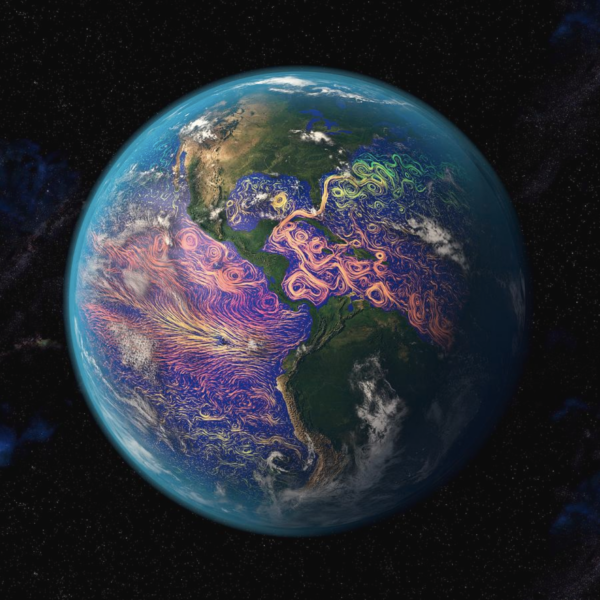
What’s good (and what’s not quite ready) about plans for ‘k-scale’ climate modeling?
[Read more…] about Mmm-k scale climate modelsAnother dot on the graph
So last week was the annual release of the temperature records from NASA, NOAA and Berkeley Earth. The Copernicus ERA5 data was released a few days ago, and the HadCRUT data will follow soon. Unlike in years past, there is no longer any serious discrepancy between the records – which use multiple approaches for the ocean temperatures, the homogenization of the weather stations records, and interpolation.
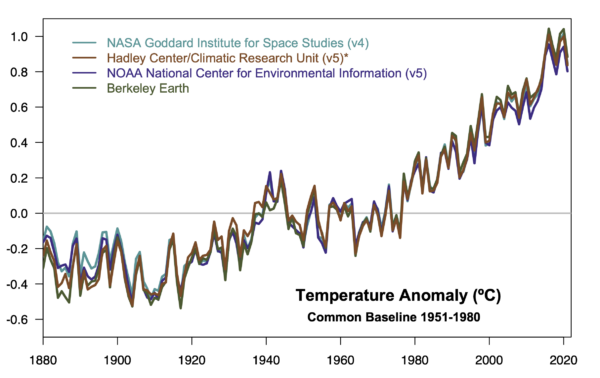
Depending on the product, 2021 was either the 5th, 6th or 7th warmest year, but in all cases, it is part of the string of warm years (since 2015) that have all been more than 1ºC warmer than the late 19th C.
[Read more…] about Another dot on the graphA Nobel pursuit
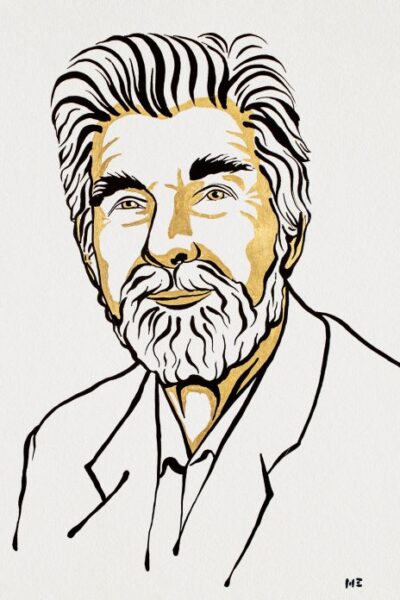

Last week, the Nobel physics prize was (half) awarded to Suki Manabe and Klaus Hasselmann for their work on climate prediction and the detection and attribution of climate change. This came as quite a surprise to the climate community – though it was welcomed warmly. We’ve discussed the early climate model predictions a lot (including some from Manabe and his colleagues), and we’ve discussed detection and attribution of climate change as well, though with less explicit discussion of Hasselmann’s contribution. Needless to say these are big topics which have had many inputs from many scientists over the years.
But RC has a more attuned audience to these topics than most, and so it might be fun to dive into the details of their early work to see what has stood the test of time and what has not, and how that differs (if it does) from their colleagues and rivals at the time.
[Read more…] about A Nobel pursuitThe definitive CO2/CH4 comparison post
There is a new push to reduce CH4 emissions as a possible quick ‘win-win’ for climate and air quality. To be clear this is an eminently sensible idea – as it has been for decades (remember the ‘Methane-to-markets’ initiative from the early 2000s?), but it inevitably brings forth a mish-mash of half-remembered, inappropriate or out-of-date comparisons between the impacts of carbon dioxide and methane. So this is an attempt to put all of that in context and provide a hopefully comprehensive guide to how, when, and why to properly compare the two greenhouse gases.
[Read more…] about The definitive CO2/CH4 comparison post